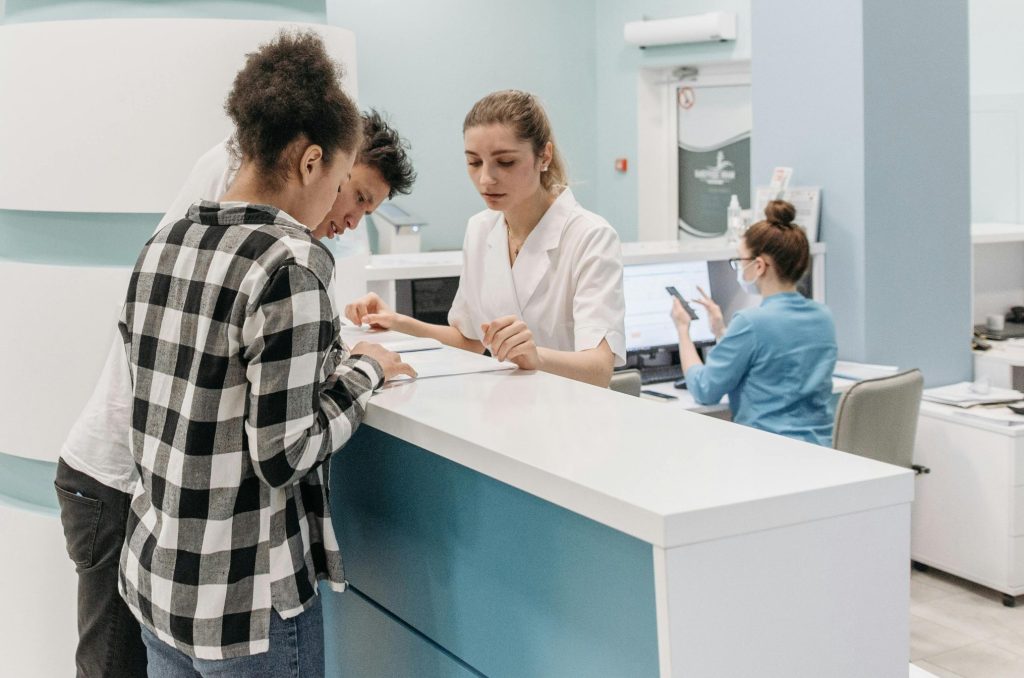Chapter 7: Scheduling and Registration Processes
Pre-Scheduled/Pre-Registered Admissions
Many areas within hospitals utilize pre-registration routines. Patient pre-registration is the process of collecting relevant patient information before the day of the scheduled visit. Like the regular patient intake process followed at the facility, pre-registration practices capture demographics, clinical data, and insurance information.
Pre-registration is typically used when a patient is being scheduled for treatment in the future and patient details must be recorded in the hospital scheduling system to book this treatment and note any important details ahead of time. Pre-registration must be used when scheduling both inpatient and outpatient elective surgery and outpatient booked procedures such as:
- MRIs
- CT scans
- Mammography
- Nuclear medicine
- Endoscopies
- Echocardiograms (and many, many more!)
Pre-Registration for Diagnostic Tests
Depending upon the hospital system, diagnostic test bookings may be transmitted directly from physicians’ and/or specialists’ offices through portals such as Ocean or electronic fax. Alternatively, patients may receive a requisition and call the outpatient department or a central booking department themselves to schedule a test.
As part of the pre-registration process, hospital booking clerks or HUCs book the patient into the clinical software system schedule for that procedure, enter basic demographic information into the clinical software system to identify the patient and speed up the registration process on the day of service, and scan the requisition to the encounter. If the requisition is received from a physician’s office, the booking clerk would also transmit the appointment information to the office. If the booking occurs through a patient call, the booking clerk would confirm the appointment and prep with the patient, reminding them to bring the requisition on the day of the test.

Pre-Registration for Elective Surgery
Patients scheduled for inpatient and outpatient elective surgery are also pre-booked in the hospital’s clinical software system; this includes both a booking in the surgeon’s OR block for that surgical date and a pre-registration for an inpatient or day surgery stay. Surgery bookings are communicated to the OR bookings department from surgeons’ offices via the surgical/OR booking form either electronically through booking portals or through fax.
This form originates in the specialist’s office and includes all of the relevant information required for the surgery, including
- the patient’s data: demographic, clinical, wait time
- operative procedure information: type of surgery, surgeon and surgical assistant, type of admission
- requirements: anaesthetic details, length of procedure, special equipment
- required pre-op preparation: pre-surgical clinic requirements, pre-op testing, day of surgery testing
Pre-Registration for Obstetrical Patients
Obstetrical admissions are also typically pre-booked in the hospital’s clinical information system. Babies’ admissions are not pre-registered and occur immediately after birth. Most systems have a registration routine that links the newborn to the mother’s chart and a system of matching armbands for both mother and baby (Thompson, 2018). Women typically move through several different areas in an obstetrical admission, including an assessment area, labour and delivery (L&D) area, and a recovery area/maternal room.
Pre-Registration Routines: Day of Admission
When any pre-registered patient presents to the hospital on the day of their procedure, the registration clerk admits them or “checks them in” in the computer, moving them from a pre-registered status to a registered status.
The registration conversation is typically shorter for pre-registered and previous patients as most information is already on file and just needs to be confirmed. Registration conversations are typically more detailed for inpatient registrations due to additional questions related
- to supplementary insurance (i.e. private or semi-private coverage as they will be staying overnight),
- increased next of kin and emergency contact information, and
- more detailed information regarding medical history.
Take Note! — Registration Conversation
The registration or admission conversation is a set of questions asked during the registration process. It usually consists of a group of screens that the HUC must move through and answer all required areas. These may change depending upon admission but always include:
- patient’s full name
- patient’s DOB
- patient’s insurance/payment information (OHIP, UHIP, extended health insurance, self-pay)
- health care providers (referring provider and performing provider, if appropriate)
- address
- medical alerts
Depending upon the type of admission, additional information may be asked, such as religion, confidentiality questions, next of kin/emergency contacts, nosocomial screening, and fall risk assessments.
Practice Activity: Pre-Registration
References
Allen, J. (2018, October 5). Optimizing surgical clock time. What I’ve Learned as a Hospital Medical Director.
A hospital stay of less than 24 hours.
Patients receiving outpatient care don’t need to spend a night in a hospital. Often they are able to leave the outpatient hospital unit/clinic immediately following their test or procedure; however, sometimes, they may need to wait until anesthesia wears off or to make sure there aren’t any complications such as bleeding.
surgical procedures that are scheduled in advance by the surgeon's office
block of operating room time the hospital allocates for a surgeon to use for surgical procedures; typically half-days or full-days
form to book patient surgical procedures at a hospital, originating in the specialist's office and sent to the hospital's OR bookings department
specific to women giving birth; whether vaginally or surgically
set of questions asked during the registration process, such as name, DOB, insurance, providers, medical alerts

